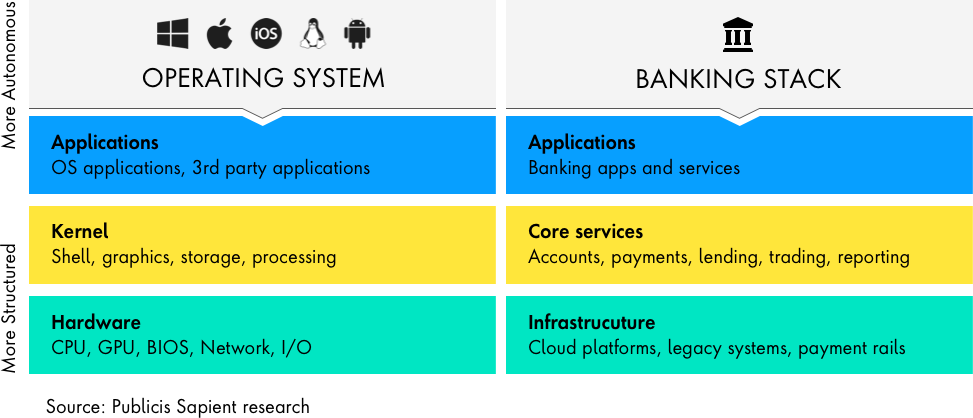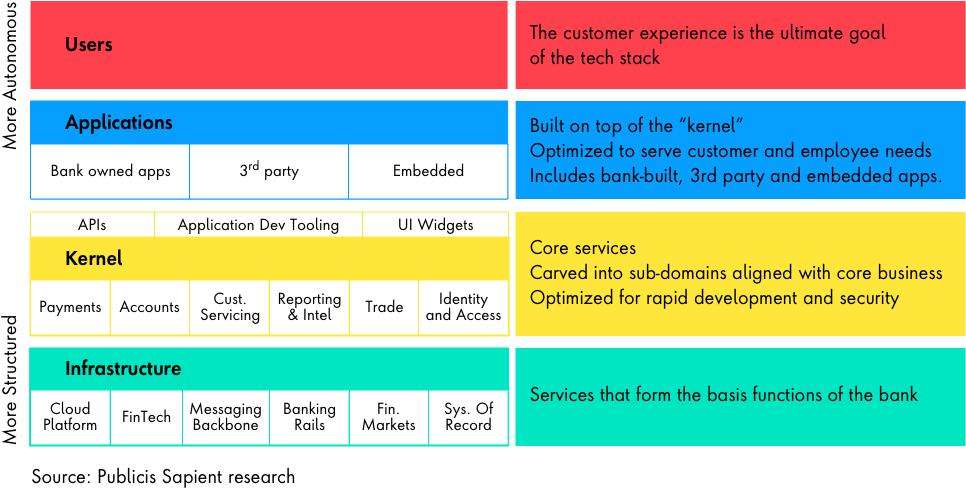What issue can we solve for you?
Type in your prompt above or try one of these suggestions
Suggested Prompt



Insights
Why Banks Should Switch to a Better ‘Operating System’
Why Banks Should Switch to a Better ‘Operating System’

Banks have invested heavily in digital transformation but are still struggling to capture the full value of their new tech architecture. The world of computer operating systems shows how they can rethink their approach and realize the potential of digitization
The digitization of banking over the past decade has followed a now-familiar pattern. Right across the industry, banks have introduced modular architectures that break their monolithic applications into smaller, task-specific components knitted together with APIs. They have swapped private data centers for scalable, cloud-based tech platforms. And they have transformed their technology culture and delivery with the adoption of Agile principles and DevOps technology, allowing much more frequent, unscheduled releases instead of the old quarterly or annual cycles.
Banks have committed to the digitization playbook because it promises major benefits. The industry’s “new stack” should help them achieve much faster technology transformation—narrowing the innovation gap that legacy-free fintechs have opened up, improving the customer experience and reaping big operational efficiencies and cost savings.
Digitization’s promise remains unfulfilled
Our experience shows that the promise of the new stack remains unfulfilled. Banks have invested heavily in digitization, but their investments have yet to deliver the scale of transformation they envisaged.
Why has banking’s digital transformation fallen short? The core of the problem is that banks’ intense focus on improving the speed of delivery has not led to system-level gains. Adopting modular architecture has resulted in multiple, semi-autonomous teams working independently on their part of the system. This creates a complexity problem for banks. It allows individual teams to move quickly, unencumbered by the strictures of the wider organization, but it results in a system that is less co-ordinated and harder to manage. What banks gain in speed with the new stack, they lose in increased complexity.
The problem with autonomy
This leads in turn to inefficiency, rising operating costs and a failure to compound the value of assets created within individual, autonomous teams across the entire organization. So, onboarding services that provide the same basic functions are implemented repeatedly by different teams, each of them unaware of or unable to use services already created by other teams. Solutions are optimized for usability with only one purpose in mind, rather than making them more generic and flexible so that multiple teams can benefit from them.
In migrating to the new stack, therefore, banks have discovered that they are losing the system-level overview and co-ordination that went hand in hand with their legacy, monolithic systems. They have committed to transforming their technology infrastructure but have not fully absorbed the implications of this transformation at the organizational level.
So, the central challenge of digitization remains unanswered: how to unlock the true potential and value of banking’s new technology stack. Addressing this critical issue is the industry’s next big opportunity.
Embrace and manage complexity
There is no going back to monoliths. Banks must instead embrace the team autonomy and system complexity that is inherent in the new stack and manage it by adopting an operating model suited to the new environment. The metaphor that best describes the solution to banking’s next challenge is not the ecosystem, but the “operating system” – a highly structured framework with the inherent flexibility to enable a rich set of applications to develop and support each other.
Applying the OS model to banking
By looking at computer operating systems, we can understand where the strengths of the OS can be applied to financial services tech stack.
The world of operating systems provides a vivid illustration of the value that structure can deliver as banking digitizes. Operating systems are designed to manage mission-critical activities in highly complex environments. They link essential hardware to the kernel that sits on top of it and is split into subsystems, each managing a core function of the OS – shell, graphics, storage, processing and so on. The kernel is both highly structured, so that it controls the essential operations reliably and safely, but also optimized for usability and flexibility so that in-house or external developers have the freedom to build applications on top of it that people will find powerful and intuitive to use.
Structure and flexibility
This combination—a robust structure to cope with complexity plus optimization that delivers flexibility and autonomy for application developers—offers an answer to banking’s big problem: how to unlock the full value of digitization. Understanding the strengths of the OS will allow banks to develop a financial services version of it that balances the forces pulling them in different directions: central control versus team autonomy; safety and compliance versus speed and agility; broad usefulness versus targeted usability.
In banking terms, think of hardware as the building blocks of the bank: cloud platforms and legacy systems, payment rails etc. These provide minimal competitive differentiation and are judged instead on functionality and cost. The bank’s ”kernel” is its core services, subdivided into domains in the same way as the OS kernel is split into subsystems, in this case accounts, payments, lending, trading, customer servicing and reporting, for example.
The bank’s kernel is the source of its competitive differentiation, sitting on top of and controlling the basic tech infrastructure while supporting the applications built on it, through which the bank delivers its services to customers.
The kernel must be highly structured to control the basic technology infrastructure effectively. It must be built not only to meet the needs technology and product teams but equally to enable effective legal, financial and audit controls. The bank’s kernel must also be optimized like the OS kernel to enable fast, flexible application development and releases, both by the bank’s autonomous product teams and by outside developers. It must ensure that innovative ideas can be re-used in multiple contexts, compounding their value to the bank and its customers.
Not just another technology layer
It is vital to understand that this is not simply a technology layer. Instead, it is a framework for understanding how the organization operates and should be managed. To succeed, banking’s OS must operate both horizontally—looking across its different service domains to identify generic needs and competences— and vertically—focusing on individual products and customer propositions.
This 3D approach to managing the organization draws on the lessons of the OS and can help banks resolve the inevitable complexity of the new technology stack. Critically, it can accommodate and balance the essential but opposing impulses that animate the organization: the drive to centralize and the thirst for autonomy.
A map of the transformation journey
Creating an organizational structure that unlocks the promise of the new stack is not straightforward. Arranging capabilities into the right set of services and teams is both an art and a science. When we help banks with their digital transformation projects, we take a target-based approach to helping them create an ideal structure for their “operating system”:
1. Prioritize and reiterate the goals for the system
2. Define service archetypes that are tied to technology and team structures
3. Outline the overall organizational structure through a “wide-lens”, incorporating domain, technology and operational designs
4. Implement enabling technology that makes the target structure achievable
5. Migrate iteratively to the target state
New architecture = new organization
It is inevitable that if organizations change the way they structure their technology, as banks have done, that will also require changes in the way the organization is managed. Structures developed to manage monolithic, legacy architectures will not necessarily survive the transition to a modular, federated architecture. After years of heavy investment and human effort, banks have made strides towards digitizing their operations. Now is the time to change the way they think about managing the complex technology system that powers their organization.
The Financial Services Operating System (FSOS) model
Managed autonomy—the key benefit of the OS—is the way that banks will capture the full value of digitization.








